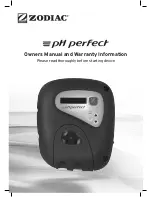
OWNER
′
S MANUAL
8
1
5
6
7
4
2
3
STORAGE & WINTERISING
This above ground pool cannot be winterised and must be drained, disassembled, and properly stored if you live in an area where the temperature drops
below 0ºC (32ºF). If you are in a warmer environment, please follow the instructions below.
After usage, you can easily empty and store away your pool in a
safe place (see Long-Term Storage above). Some pool owners, in warmer climates however, may choose to leave their pool up all year round. In cold areas, where
freezing temperatures occur, there can be a risk of ice damage to your pool. Leaving your above ground pool set up in areas where the temperature drops below
0ºC (32ºF) voids the warranty.
Winterising Your Above Ground Pool
1. Clean the pool water thoroughly.
2. Remove the skimmer (if applicable) or any accessories attached to the threaded strainer connector. Replace strainer grid if necessary. Be sure all accessories
parts are clean and completely dry before storage.
3. Plug the Suction and Return Fittings from the inside of the pool.
4. Remove the ladder (if applicable) and store in a safe place. Be sure the ladder is completely dry before storage.
5. Remove the hoses that connect the pump and filter to the pool.
6. Add the appropriate chemicals for the winter period. Consult your local pool dealer as to which chemicals you should use and how to use them. This can vary
greatly by region.
8. Clean and drain the pump, filter housing, and hoses. Remove and discard the old filter cartridge. Keep a spare cartridge for the next season.
9. Bring pump and filter parts indoors and store in a safe and dry area, preferably between 0ºC (32ºF) and 40ºC (104ºF).
Repair
1. Use a mix of liquid dish soap and water in a spray bottle, and spray over suspicious areas. Any leak will produce bubbles that will pinpoint the location of the leak.
2. Thoroughly clean the area surrounding the leak to remove any dirt or grime.
3. Cut a piece of repair patch (included) with a margin of 0.8” (2cm) larger than the damaged area, rounding the corners with scissors.
4. Place the patch over the centre of the leak, press down firmly, and squeeze out all air bubbles to the edges. You may want to put a weight on top to keep it in place.
5. Do not inflate for one hour after patching.
NOTE:
if the patch does not hold, you can use the patch with silicone- or polyurethane-based glue designed for repairing camping mats, tents or shoes. Consult your
local household/camping supply stores, and follow the instructions of the glue you’ve chosen.
4. Attach a 5/8” garden hose to the drain valve.
5. Place the other end of the garden hose in an area where the water can be safely drained away from the house and other nearby structures.
6. Unplug the inner cap of the drain plug to start draining the pool.
7. When the water stops draining, start lifting the pool from the side opposite to the drain valve to drain any remaining water and empty the pool completely.
8. Replace the drain cap on outside of pool.
9. Completely deflate the top ring, and remove all connecting parts.
10. Be sure that the pool and all parts are completely dry before storage. Air-dry the liner in the sun completely before folding (see drawing
1
). Sprinkle some
talcum powder to prevent the vinyl from sticking together and to absorb any residual moisture.
11. Create a square shape. Starting at one side, fold one-sixth of liner into itself twice. Do the same on the opposite side (see drawings
2
&
3
).
12. Once you have created two opposing folded sides, simply fold one over the other like closing a book (see drawings
4
&
5
).
13. Fold the two long ends to the middle (see drawing
6
).
14. Fold one over the other like closing a book, and finally compact the liner (see drawing
7
).
15. The liner and accessories must be stored in a dry, temperature-controlled storage location above 0°C (32°F) and below 40°C (104°F).
16. The original packing can be used for storage.



























